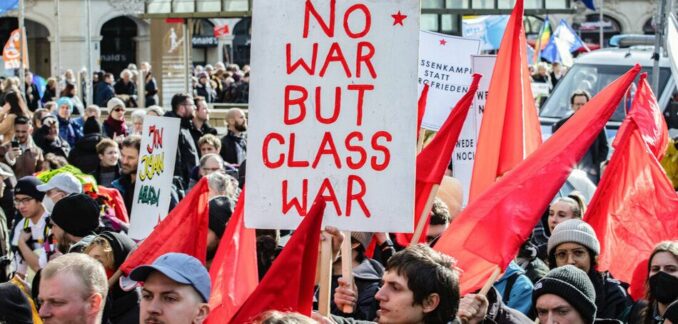What led to a long war
Imperialist politicians and media are flooding the public with the same lies that they’ve been hyping all year about the U.S.-NATO proxy war in Ukraine. President Joe Biden’s provocative visit to Kiev Feb. 20, bearing gifts of more weapons to expand the war, heightens the danger to the world.

3,000 anti-imperialists demonstrate near the imperialist-run Security Conference in Munich, Germany, Feb. 18, 2023.
It’s still within the power of the working class in Europe and the U.S. to obstruct the imperialist offensive.
What’s needed is an antidote to the poison from the corporate media. A concise list of events show how Washington forced this war to happen.
On March 12, 1999, NATO inducted the Czech Republic (or Czechia), Hungary and Poland into the U.S.-led alliance. This act exposed as false U.S. Secretary of State James Baker’s 1991 pledge that “NATO would not move its armies one inch closer to the Russia border.” (New York Times, Jan. 9, 2022)
Just 12 days later the U.S., with its major NATO allies, launched bombs and rockets at bridges, schools and hospitals in Serbia and Montenegro. The attack lasted 79 days. The war paved the road to annihilating the multinational Yugoslav socialist state.
U.S. agencies manipulated the so-called “Orange Revolution” in Ukraine in 2004, which replaced a government friendly to Russia with one more dependent on the West. Then from 2013 through 2014, U.S. agencies financed and promoted the so-called Maidan revolution, a fascist-infested revolt that expelled the elected president and imposed an anti-Russian coup regime in Kiev.
Kiev attacks ethnic Russians
This gang’s first act was to squash the Russian language in Ukraine.
The Crimean peninsula had been part of Russia from 1783 until 1954. In 2014, Crimea’s mostly ethnic Russian population chose in a referendum to rejoin Russia. Using Russia’s recovery of Crimea as a pretext, Washington arm-twisted European Union countries to target Russia with economic sanctions.
People who lived in the two provinces of the Donbass region, also mostly ethnic Russian, established independent republics in Donetsk and Lugansk in 2014. Kiev answered this cry for self-determination by waging war on the two republics.
Cease-fire agreements signed in Minsk, Belarus, in September 2014, failed to stop the fighting in Ukraine. In a Dec. 7, 2022, interview in the German newspaper, Die Zeit, former German Chancellor Angela Merkel admitted that the EU and Kiev used the agreements to buy time to strengthen Ukraine’s military. During the next eight years, the Ukrainian Army killed 14,000 people in the Donbass.
NATO expanded from 19 members in 1999 to 30 in 2022, including countries that were part of the Soviet Union and most of the countries that had been allied with the Soviet Union before 1991. NATO held provocative military exercises that moved ever closer to the Russian borders, while the U.S. started deploying potential first-strike nuclear weapons in Europe.
Faced with what was arguably an existential threat, the Moscow government opened its military intervention in Ukraine a year ago. Washington immediately began waging a proxy war against Russia, arming Ukraine and using its population as cannon fodder, pressuring its NATO allies to spend more money on weapons and to arm Kiev’s troops with weapons available in the allies’ stockpiles.
Last March, the U.S. sabotaged tentative moves toward Ukrainian-Russian negotiations, while demanding Europe break its mutually beneficial trade ties with Russia.
U.S. political and military leaders have said openly that their goal was to extend the war to weaken Russia. Imperialist politicians and media demonized Russian President Vladimir Putin, just as they did to Iraq’s Saddam Hussein, Libya’s Moammar Gadhafi and Yugoslavia’s Slobodan Milosevic — before invading and destroying their countries.
As renowned journalist Seymour Hersh recently revealed, U.S. forces even carried out an act of terror by bombing the Russian-owned Nord Stream pipelines in the Baltic Sea. (tinyurl.com/bdhn647j) This act prevented German leaders — had any been considering the possibility — from reestablishing Germany’s trade with Russia for its gas and oil. (workers.org/2022/10/66955/)
Until now the European NATO regimes, while sometimes expressing hesitations, have lined up behind Washington’s aggression. The strongest opposition would come mainly from the working class, who pay the social costs of the war and risk getting involved in a major catastrophe. The outbreaks of class struggle in France, Spain, Italy and Portugal are a sign of hope.
This chronological list of events shows that the antiwar movement in Europe and the U.S. has its enemy in Washington and in the Western European capitals. The movement’s rightful demands are clear: U.S. and NATO out! No weapons to Ukraine! End the sanctions!

